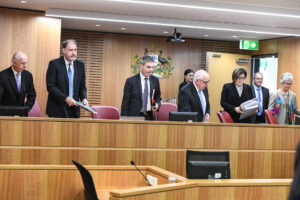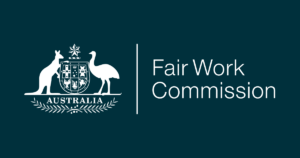The decision by the Fair Work Commission to increase the minimum wage by 5.2 per cent is a rare bright spot for workers in what has been a terrible decade for wage increases.
This increase represents an extra $1.05 per hour or about $40 per week for someone working full time.
About 2.3 million workers are on the minimum wage, or paid on awards that are linked to the minimum wage.
All up about a third of workers are either on the minimum wage or an award, individual contract or enterprise agreement that is linked to the minimum wage.
Wages have been stagnant for almost a decade.
When it comes to bargaining power between workers and business, it has clearly been business that has had the upper hand.
Profits have grown seven times faster than wages
Over the past six years profits have grown seven times faster than wages.
While there will undoubtedly be some businesses that will feel the pressure of the wage increase, it is also true that many workers are struggling to make ends meet, even when they’re working full time.
Welfare agencies are reporting they are now having to help a new cohort of people; those who have jobs.
People with full-time jobs are increasingly living in tents and in their cars.
The Fair Work Commission decided a 5.2 per cent increase in the minimum wage was appropriate because of the big increase in inflation.
The Consumer Price Index, our main measure of inflation, has increased by 5.1 per cent over the past year.
Workers finding it hard to negotiate higher wages
An unemployment rate at 40-year lows would normally lead to higher wages.
But that is not what’s happening, in part because of the increasing number of workers who don’t have access to certainty of hours, paid leave, and good working conditions.
After decades of eroding workers’ bargaining power, including by restricting the power of unions, we have reached a point where workers find it incredibly difficult to negotiate higher wages.
This all means that the ‘market’ is failing to deliver decent pay increases.
This makes institutions like the Fair Work Commission even more important for delivering wage increases.
The Fair Work Commission’s decision to increase the minimum wage is a clear rejection of the arguments of the former federal government and many business leaders that it should be workers who again take a hit to their living standards via a cut to their real wages.
This is in line with public sentiment.
Public on side with decision
An Australia Institute exit poll at the last federal election showed a very strong majority of voters (83 per cent) supported the idea that wages should at least keep up with prices.
This opinion was shared broadly across the political spectrum.
Even 79 per cent of Coalition voters supported lifting wages to at least keep up with inflation.
While this decision is a step in the right direction, the ACTU rightly points out this increase in the minimum wage is not a real wage increase.
Wages are simply keeping pace with inflation.
The Reserve Bank is now predicting that prices will continue to rise to 7 per cent by the end of the year.
If this happens then the minimum wage will again lag behind inflation. This also comes after a 2.5 per cent decline in real wages last year.
There has been concern that this increase to the minimum wage will add to inflation. But an increase of 5.2 per cent is not enough to push inflation higher.
Workers have faced a decade of stagnant wages
Wages can rise as fast as inflation plus productivity growth without adding to inflation.
The CPI has increased by just over 5 per cent and productivity has been growing at about 1 per cent per year.
This means wages need to grow by more than 6 per cent to add to inflation.
It is also important to remember that a 5 per cent increase in wages is not the same as a 5 per cent increase in all business costs.
Wages are just one of many business costs. On average, across the economy wages make up about 25 per cent of business expenses.
Workers have faced almost a decade of stagnant wages and more recently the biggest fall in their real wages since records began.
This increase in the minimum wage goes some way to improving the lives of millions of Australian workers.
But more needs to be done to improve the bargaining power of all Australia’s workers. Otherwise, we can expect another decade of stagnant wages.
Matt Grudnoff is senior economist at the Australia Institute.
Between the Lines Newsletter
The biggest stories and the best analysis from the team at the Australia Institute, delivered to your inbox every fortnight.
You might also like
If business groups had their way, workers on the minimum wage would now be $160 a week worse off
Had the Fair Work Commission taken the advice of business groups, Australia lowest paid would now earn $160 less a week.
The continuing irrelevance of minimum wages to future inflation
Minimum and award wages should grow by 5 to 9 per cent this year
Minimum wage increase would not impact inflation
The Australia Institute supports the call for a real wage increase for those on the minimum wage and award wages.



